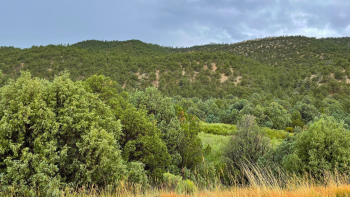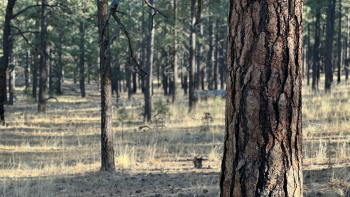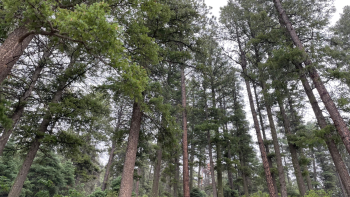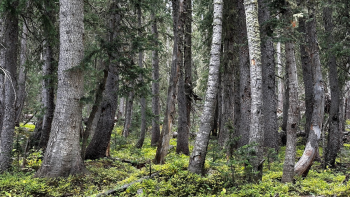Fire Ecology
Most of the vegetation on the Carson National Forest is adapted to recurrent wildland fires started by lightning from spring and summer thunderstorms. Frequent low- to moderate-intensity fires play a vital role in maintaining the health of many fire-dependent ecosystems.
Properly managed fire—both planned and unplanned—is a tool for restoring these fire-dependent ecosystems. When appropriate weather and fuel conditions exist, wildland fire is a cost-effective tool for reducing the likelihood of uncharacteristic wildland fire and restoring ecosystem function.
Overall, the forest’s goals for wildland fires include:
- Wildland fires burn with the range of severity and frequency of historic fire regimes for the affected vegetation communities.
- Naturally ignited and planned wildland fires move ecosystems toward desired conditions and protect, maintain, and enhance resources.
- Fire functions in its natural ecological role on a landscape scale and across administrative boundaries, under conditions where safety and values at risk can be protected.
- In frequent fire systems, regular fire mitigates high-severity disturbances and protects social, economic and ecological values at risk, like people, communities and forest health.
- Planned and natural ignitions predominate. Unplanned human-caused ignitions are rare.
Vegetation Communities
A vegetation community is not uniform but encompasses a mosaic of conditions that share similar ecological processes, growth dynamics and responses to disturbances. Let’s take a look at the main vegetation communities on the forest: piñon-juniper, ponderosa, mixed conifer (both dry and wet) and spruce-fir. Each of these communities has a different relationship with fire. They are listed by elevation, from low to high.

Piñon-juniper woodland.
(Ladoshie Holman/USDA Forest Service)Fire is typically infrequent with mixed severity in these two vegetation communities that cover a quarter of the Carson National Forest from 5,900 to 7,500 feet in elevation. The tree density is naturally high in woodlands while the understory in piñon-juniper mixed with sagebrush can have moderate to high density of shrubs.
Fires in small patches or single trees may occur with some frequency (on the order of decades) while larger, mixed to high-severity fires are infrequent (on the order of centuries).
Wildland Urban Interface
In the wildland urban interface, where the forest and human development intermingle, forest crews will thin and use prescribed fire to reduce fuels and give space for firefighters to safely work in the event of a future wildfire.

Ponderosa stand.
(Zach Behrens/USDA Forest Service)Stands of ponderosa pine are usually found between 6,000 and 7,500 feet in areas that are moister. They cover about 20% of the Carson National Forest. In some areas, you’ll find ridgetops of ponderosa pine transitioning to valley bottoms dominated by piñon-juniper or ponderosa pine in wetter drainage bottoms, surrounded by piñon-juniper.
Along with ponderosa pine trees, Gambel oak, piñon pine and juniper may also be present in the vegetation community. There is typically a productive grass-forb-shrub understory and extensive space between individual or groups of trees. Ponderosa pine trees have developed mechanisms to tolerate frequent, low-intensity surface fires and adapt to drought during the growing season.
Ponderosa pine stands across the forest are highly departed from historic conditions due to past management activities. The result has significantly reduced the ability of fire to play a natural role and has allowed fire-sensitive species, like white fir, to establish. Stands are dense and homogeneous, lacking an open canopy or large trees and snags for wildlife habitat. This makes the current ponderosa pine forest vegetation community extremely susceptible to large, uncharacteristically severe wildfire and other disturbances(especially dwarf mistletoe) that will be exacerbated under a warming and drying climate.
Wildland Urban Interface
When restoring ponderosa pine in the wildland-urban interface, forest staff seek to return historic conditions at their low range to reduce fire intensity and assist the control of fire. In comparison to other ponderosa pine forests on the Carson National Forest, that means:
- A lower density of snags, downed logs, coarse woody debris, live trees and Gambel oak.
- Smaller and more widely spaced groups of trees.
- Higher crown base heights, which is the distance between the ground and the lowest branch, to reduce the potential of fire spreading to the canopy.

Mixed conifer with frequest fire vegetation community.
(Ladoshie Holman/USDA Forest Service)Often referred to as “dry mixed conifer,” this vegetation community occupies about 12% of the Carson National Forest between 6,000 and 10,000 feet. When fire is episodic and low- to mixed-severity, both mature and juvenile white fir are killed and an open forest structure is maintained with fire-adapted ponderosa pine and Douglas-fir in the overstory, and Gambel oak, creeping barberry and mountain snowberry common in the understory.
The natural fire regime is currently highly departed and has resulted in dense, homogeneous stands with a shift toward more shade-tolerant tree species that are not adapted to fire. These dense conifer stands outcompete aspen, which would have been a historically minor and dispersed component in this vegetation community but is now much less common.
Dense stands are susceptible to insects and disease and much more at risk from large, high-severity fire. There are many fewer openings that support grass, forb and oak cover than there would have been historically, which results in less forage for wildlife and livestock grazing.
Wildland Urban Interface
Forest staff design restoration efforts in the vegetation community to reduce fire behavior, so that fires primarily burn on the forest floor and occasionally consume single-trees or small groups of trees, but does not spread throughout the canopy. To accomplish this, compared to other dry mixed conifer forests:
- Groups of trees are smaller and more widely spaced.
- The number of snags and coarse woody debris is less.
- The crown base heights are higher.
- Groundcover consists primarily of perennial grasses and forbs.

Mixed conifer with aspen vegetation community.
(Ladoshie Holman/USDA Forest Service)This vegetation community is found in the cooler, wetter sites within the mixed conifer life zone at 7,000 to 10,000 feet, which is why it’s frequently referred to as “wet mixed conifer.” It’s found throughout about 9% of the forest. Fires here are less frequent and characterized by mixed to high severities.
Dominant and codominant vegetation here varies by elevation and moisture availability. Ponderosa pine occurs incidentally or is absent, while Douglas-fir, southwestern white pine, white fir and Colorado blue spruce can be dominant or codominant. Oregon boxleaf is characteristic in the understory, but a wide variety of other shrubs, graminoids and forbs may be present, depending on soil type, aspect, elevation, disturbance history and other factors.
The distinguishing feature of this vegetation community is the presence of quaking aspen after disturbances, such as fire. Fire exclusion has reduced opportunities for aspen establishment. Aspen in this vegetation community is slightly less common than it was historically and young aspen stands are particularly rare. When combined with predicted warming and drying, the current stand conditions are likely to become increasingly susceptible to insects, disease and large, uncharacteristic wildland fires in the future.
Wildland Urban Interface
For the wildland urban interface, forest staff manage for stands dominated by fire-adapted species growing in a more open condition than in the surrounding general forest. These conditions result in fires that burn primarily on the forest floor and rarely spread as crown fire.

A spruce-fir forest.
(Zach Behrens/USDA Forest Service)Covering about 20% of the forest, this vegetation community occupies the coldest and wettest forested slopes, ridges and valleys on the forest. It covers nearly 290,000 acres, or about 20% of the forest, at elevations between 9,000 and 11,500 feet, below the alpine and tundra zone.
Engelmann spruce, western subalpine fir, and corkbark fir are the dominant species. Near timberline, firs are less abundant; at lower elevations, mixed conifer species may be present. Below 10,500 feet, quaking aspen occurs following disturbances and may be dominant or codominant. Common understory species include whortleberry, huckleberry, common juniper, Oregon boxleaf, spruce-fir fleabane, Jacob’s-ladder, Parry’s goldenrod and strawberry. As a result of past logging, fewer large trees exist now than there were historically.
The disturbance frequency in the spruce-fir forest vegetation community is both historically and currently low, but the natural disturbance regime includes infrequent, but large, high-intensity events like wind throw, stand replacing wildfire, and spruce beetle epidemics. The current disturbance regime in the spruce-fir forest vegetation community is probably not outside the historic norm.
Wildland Urban Interface
Forest staff seek to strategically create areas in a more open condition than occur in the surrounding general forest in order to mitigate the threat from high-severity wildfire that otherwise is naturally present. Grass, forb and shrub vegetation and aspen may make up a much larger percentage of the wildland-urban interface than they do in the general forest. Structures should be surrounded by grassy openings with very few to no trees, such that available fuels support surface fires and inhibit crown fire.


